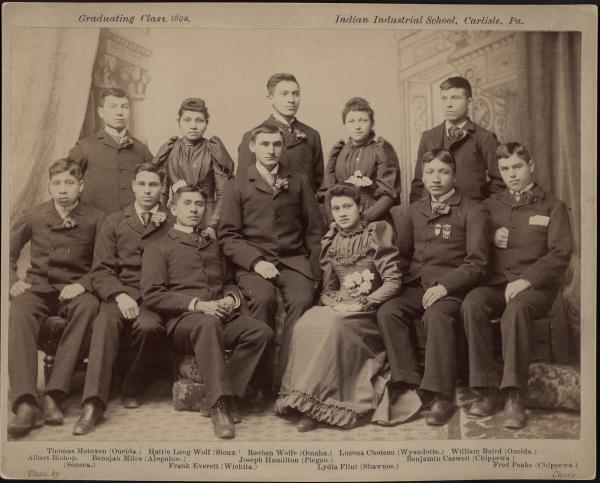
The caption reads: Graduating Class, 1892. Indian Industrial School, Carlisle, Pa. Thomas Metoxen (Oneida.) Hattie Long Wolf (Sioux.) Reuben Wolfe (Omaha.) Luzena Choteau (Wyandotte.) William Baird (Oneida.) Albert Bishop, (Seneca.) Benajah Miles (Arapahoe.) Joseph Hamilton (Piegan.) Benjamin Caswell (Chippewa.) Frank Everett (Wichita.) Lydia Flint (Shawnee.) Fred Peake (Chippewa.) Photographer: John N. Choate, Carlisle, PA
1/10/14 ICTMN.com
Want to know more about students who attended Carlisle Indian Industrial School? Now doing just that is far easier.
Stories of Sioux children like Elsie Robertson, or Pueblo children like Bruce Fisher can now be read online, as can parts of the lives of the many thousands of students who attended Carlisle between the years of 1879 and 1918.
Readers can find this information on the Carlisle Indian Industrial School Project page of Dickinson College of Carlisle, Pennsylvania. The college’s Community Studies Center (CSC) and its Archives and Special Collections Department put the project together in 2013 and since August of last year they have been sending teams of researchers to the National Archives to scan and digitize information relating to CIIS.
This week, project directors sent another team to the Archives to continue with the process. One of the directors, College Archivist Jim Gerencser, noted that they had already digitized 1,250 files, comprising about 11,000 pages of text.
“We think that within three years we should be able to capture all the information from the Bureau of Indian Affairs (BIA) files,” Gerencser said.
He also said that they had been in contact with a group of CIIS descendants on Facebook and were hoping to inspire other people with connections to the school to come forward. The first page of the project’s website extends an invitation also.
“Desiring to add to the school’s history beyond the official documentation, we will seek partners among those institutions that hold additional records regarding the school, its many students, and its instructors. Subsequent phases of this project will develop the capability for user interactivity, so that individuals may contribute their own digitized photos, documents, oral histories, and other personal materials to the online collection. The website will also host teaching and learning materials utilizing the digitized content and database, and will support the addition of original scholarly and popular works based on the Carlisle Indian Industrial School Project resources.


